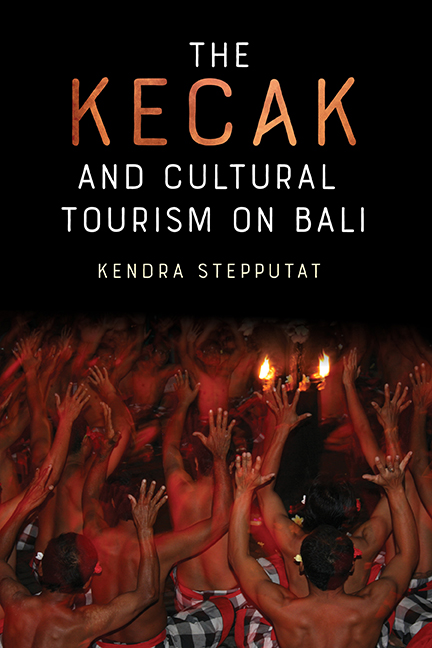Book contents
- Frontmatter
- Contents
- Acknowledgments
- Note to the Reader
- Introduction
- Part 1 The Present
- Part 2 The History
- Appendix 1 Kecak dan Wisata Budaya di Bali (Indonesian Summary)
- Appendix 2 Kecak Groups of Bali in 2000–2001 (Badung and Gianyar)
- Appendix 3 Facsimile of a Letter from Walter Spies to Leo Spies, 1932
- Glossary
- Bibliography
- Index
8 - Almost a Century of Kecak
Published online by Cambridge University Press: 07 October 2022
- Frontmatter
- Contents
- Acknowledgments
- Note to the Reader
- Introduction
- Part 1 The Present
- Part 2 The History
- Appendix 1 Kecak dan Wisata Budaya di Bali (Indonesian Summary)
- Appendix 2 Kecak Groups of Bali in 2000–2001 (Badung and Gianyar)
- Appendix 3 Facsimile of a Letter from Walter Spies to Leo Spies, 1932
- Glossary
- Bibliography
- Index
Summary
When the kecak was established as a genre, it was already a performance for tourists, designed to their taste. But such a genre, which has been closely related to tourism from the very beginning, is extremely susceptible to periods of prosperity and crises. In the course of the twentieth century, Bali has undergone political and social turmoil, suffered from famine, been occupied during the Second World War, seen the struggle for independence turn into civil war, and lost thousands in the mass killings following 1965. The further development of kecak during the twentieth century cannot be regarded separately from all these circumstances; on the contrary, these local, national, and global events and the responses to them by Balinese individuals have shaped the kecak.
1930s–1940s: Kecak Becomes a Tourist Attraction
“Although this performance [the kecak] was an instant success among Spies’ friends and passing visitors, the Balinese seem to have rapidly lost interest in it.”1 Indeed, kecak performances were targeted to a foreign audience almost immediately after the genre originated. The earliest source to mention the kecak as a tourist attraction is Walter Spies himself. In a letter to his friends Colin McPhee and Jane Belo, Spies writes about how he had to organize a kecak performance for the visit of the general governor of the Dutch East Indies:
The next one was the Gener. Gouverneur. Never in my life was I so busy – although I had nearly nothing to do with him. Every Controleur asked me to help. You can't imagine Jane, what Bali looked like on those days the GG. was here! […] I had to arrange the Ketjaks of course. The whole Samoetiga temple in Bedoeloe was illuminated; gates, walls etc. With 5,000 klapa lamps. The Ketjaks were sitting under a specially built bale surrounded by concentric rows of damars—beginning very low and getting higher and higher towards the back—amphitheatrically. It looked absolutely the most incredible thing you ever saw, and not at all too light or too dark, just right.
The general governor was not a tourist on Bali, but he was a visitor to the island interested in witnessing and watching performances of Balinese dances and music. His expectations were not far from those of current cultural tourists when they go to Bali and watch a kecak performance.
- Type
- Chapter
- Information
- The Kecak and Cultural Tourism on Bali , pp. 286 - 330Publisher: Boydell & BrewerPrint publication year: 2021



